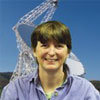A trip to Snowshoe Mountain Ski Resort in rural West Virginia is unlike any other. And it’s not because of the powder, the runs or the ski lodge.
Snowshoe is smack in the middle of the 13,000 square-mile National Radio Quiet Zone (NRQZ). It’s the only place in the U.S. where cell phone towers and similar equipment is severely restricted and, in some cases, completely illegal. However, thanks to AT&T engineers, as well as NRAO and Snowshoe staff, Snowshoe Mountain Ski Resort is an oasis of cellular connectivity in the middle of the Quiet Zone.
I’m the Site Director at the Green Bank Radio Telescope, which is located at the National Radio Astronomy Observatory in West Virginia. For me, life without wireless connectivity is normal. In 1958, the NRQZ was set up to minimize possible harmful electromagnetic interference to the Green Bank Radio Telescope. Here, we operate the world's largest fully steerable radio telescope with a dish covering 2.3 acres. We use the telescope to receive very faint signals from outer space to help us learn about the stars, the universe and how humankind came to be here.
But here’s the kicker – the telescope has radio sensitivity. Any interference from man-made electronic devices can overwhelm the signals being received by the telescope. While the rest of the U.S. is constantly checking emails and posting updates on social media, our Quiet Zone feels like stepping back in time.
However, skiers at Snowshoe want to stay connected on the slopes. They need a connection in case of emergency – but they also want to use apps, send photos and check social media. The strict quiet zone restrictions present a unique challenge to wireless carriers.
We worked with AT&T engineers to design a Distributed Antenna System (DAS) to meet our strict radio frequency emissions guidelines. The effort involved detailed elements covering DAS design and system optimization. The engineers needed to working closely with our technicians and engineers to monitor, inspect and license each of the 180 antennas throughout the resort. Today, AT&T is the only carrier that has been able to solve the riddle and gain approvals to operate on the DAS at the resort.
AT&T’s engineers showed their ingenuity by developing radio frequency code that automatically switches cellular devices used at Snowshoe to a low-power mode. For context, your cell phone usually emits 500 milliwatts while in use. At Snowshoe it’s “quieted” to 1/1,000th of a watt or less. The Snowshoe DAS features nearly 3 miles of fiber and more than 180 antennas clustered throughout high-traffic areas, which densifies the network – shortening the distance signals travel to connect a call, send a text or post to social media.
After months of work, and more time certifying signals, we were able to give the green light on the DAS. The close relationship between the NRAO and AT&T is ongoing as our inspectors monitor power levels at Snowshoe on a weekly or even daily basis. Even more, as demand increases we continue to work with engineers to certify ongoing expansions throughout the resort.
The work we do with the Green Bank Radio Telescope is rare. Very few places throughout the world replicate it. We’re working to solve massive questions like the origins of our universe or to possibly communicate with extraterrestrial life. AT&T’s work at Snowshoe is about helping you communicate with life on this planet, but we’ve enjoyed being part of the journey.
About the author: Dr. Karen O’Neil is the Green Bank Site Director for the National Radio Astronomy Observatory’s site in Green Bank, West Virginia.

